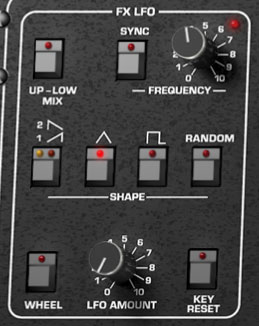The FX-LFO and FX Mono-Mod sections work exactly like the similar sections on the main UI page, but instead of the LFO modulating synthesis parameters, they're set up to modulate key effects parameters.
To be 100% clear: the FX-LFO and FX-Mono Mod sections function totally independently of the LFO and Mono Mod sections on the main synth parameters page.

Up-Low Mix- This is a unique feature of the original instrument that mixes the LFO outputs of the Upper and Lower layers. The main intention of this isn't necessarily obvious: if you'd like to apply the same modulation to both the Upper and Lower layer effects mod, set the LFO controls as desired on one layer, then enable Up-Low Mix and disable all mod waveforms on the other layer. This effectively allows one layer's LFO to affect both layers. (Make sure to set the LFO Amount knob and destination buttons in the FX Mono-Mod section the same for both layers.)
Up-Low Mix can also be used to create unique LFO mod waveshapes by combining waveforms and differing mod frequencies from each LFO. This works particularly well when Sync is enabled, because the LFO's will move together in logical subdivisions for unusual but congruent mod waveshapes.
Sync- When the Sync switch is enabled, LFO frequency will lock to host tempo when using P-10 within DAW software, or to the current tempo in the top menu bar when using the standalone version. The Frequency knob will snap from 8 beats up to 1/64th note triplets.
Frequency- The Frequency knob sets LFO speed , from 0.05 to 31.5 Hz (with Sync switch off). The LED beside the Rate knob flashes at the current modulation rate, and visually indicates the curve of the current mod waveform.
Shape- Sets the LFO mod waveform. The waveforms include unipolar sawtooth and ramp, bipolar triangle, unipolar square, and bipolar random. For a full explanation of unipolar vs. bipolar waves, please see the LFO and Mono-Mod chapter.
Wheel- Enables and disables mod wheel controller data. When disabled, LFO depth is solely controlled by the LFO Amount knob. When the the Wheel button is enabled, the mod wheel and LFO Amount knob signals combine to control LFO depth additively.
LFO Amount- Sets the initial amount of LFO modulation routed to the FX Mono -Mod section destination buttons.
Key Reset- Resets the LFO modulation cycle when a new key is pressed (but no other keys are currently held). This is particularly useful when the Sync button is enabled, and allows rhythmically synced modulation. It's most useful with the saw, square, and random waves.
FX Mono-Mod

The FX Mono-Mod section determines how FX LFO control signals are routed.
Source Mix- Determines the Mono-Mod section source, allowing selection between the LFO or noise source, or a mix thereof. This a dubiously useful "copied from Minimoog" feature - you'll most likely leave this set fully counterclockwise to the LFO position.
Destination- These toggle buttons determine how LFO mod is routed. They can be used singly or in any combination. Destinations are as follows:
Dist Drive- LFO modulates the Distortion effect Drive amount control.
Phase Depth- LFO modulates the Phaser effect Depth control.
Chr/Flng Depth- LFO modulates the Chorus/Flanger Depth control.
Delay Time- LFO modulates the Delay effect Time control.
Delay Fdbck- LFO modulates the Delay effect Feedback control.
Reverb Mix- LFO modulates the Reverb effect Mix control.
Using FX-LFO To Modulate the Chorus/Flanger and Phaser
Since the Chorus/Flanger and the Phaser have their own "built-in" low-frequency oscillator modulation with dedicated Rate and Depth controls, this is designed so that the more powerful FX-LFO can be substituted for the basic inbuilt LFO's. This is really simple to do - just set the Chorus/Flanger or Phaser Depth controls to zero. When Phase Depth or Flng/Chor Depth destinations are selected in FX Mono-Mod and LFO Amount knob is increased, the FX-LFO will act as the only mod source. Not only does this allow mod via the FX-LFO's extended selection of waveshapes, it also allows mod to be synced with DAW projects and as well as the LFO on the synth parameters page.
Alternatively, internal Chorus/Flanger or Phaser mod may be combined with FX Mono-Mod for unique mod shapes.